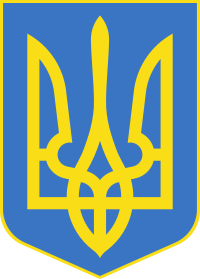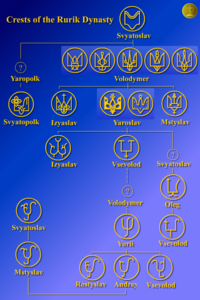Coat of arms of Ukraine
| Coat of arms of Ukraine | |
 |
|
| Details | |
|---|---|
| Armiger | Government of Ukraine |
| Adopted | 1991 |
| Escutcheon | Azure, a Tryzub Or |
The Coat of Arms of Ukraine (Tryzub) features the same colours found on the Ukrainian flag: a blue shield with yellow trident—a symbol (Tamgha) of Turkic origin, later adopted by the rulers of the Rus' Khaganate.


The coat of arms is a yellow trident, called tryzub (тризуб) with a blue background.
Contents |
History
The history of the trident symbol as featured in the current Ukrainian coat of arms is more than 1000 years old. The first known archeological and historical evidence of this symbol can be found on the seals of the Rurik dynasty. The tryzub was stamped on the gold and silver coins issued by Prince Volodymyr the Great (980–1015), might have inherited the symbol from his ancestors (such as Sviatoslav I Ihorovych) as a dynastic coat of arms and passed it on to his sons, Sviatopolk I (1015–19) and Yaroslav the Wise (1019–54).
The tryzub was also found on the bricks of the Church of the Tithes in Kyiv, the tiles of the Dormition Cathedral in Volodymyr-Volynskyi, and the stones of other churches, castles, and palaces. There are many examples of it used on ceramics, weapons, rings, medallions, seals, and manuscripts. Since the tryzub was so widely used, it evolved many variations without losing its basic structure. Almost 200 medieval variations of the tryzub have been discovered in Ukraine.
Interpretation
There is no sure and definite interpretation of the symbol, however, most historians agree that it most probably depicts a stylized hawk or some other totem of the first Rurikid ruler's family. The use of this symbol has been supplanted since the 11th century by the Christian tradition of using the images of the saints (most notably Saint George or Saint Michael) considered to be the protectors of the ruling family, and later by Galician or Cossack heraldic or cultural images. The trident was not thought of as a national symbol until 1917, when one of the most prominent Ukrainian historians, Mykhailo Hrushevsky, proposed to adopt it as a national symbol (alongside other variants, including an arbalet, a bow or a cossack carrying a musket, i.e. images that carried considerable historical and cultural and heraldic significance for Ukraine). On 22 March 1918, the Central Rada adopted it as the coat of arms of the short lived Ukrainian National Republic.
The Great Coat of Arms

The Great Coat of Arms of Ukraine was never officially adopted, but it was published in various heraldic sources. In this variant the shield is supported by a crowned lion from the Galician Coat of Arms on the left and a cossack in traditional dress, wielding a musket, the symbol of the Cossack Hetmanate on the right. The Coat of Arms is crowned with the crown of Volodymyr the Great, symbolizing Ukrainian sovereignty, and decorated with viburnum and wheat at the bottom. The official adoption of the Great Coat of Arms has to be endorsed by a majority by two thirds in the Ukrainian parliament. This has not yet been reached by this date (2008) because of the resistance of Communists and pro-Russian parties.
Archangel Michael
Archangel Michael, the symbol of Ukraine, joined the Eagle and Pahonia during the January Uprising.
References
- Pritsak, Omeljan. The Origins of the Old Rus' Weights and Monetary Systems. Cambridge, MA: Harvard Ukrainian Research Institute, 1998
- Arkadii Zhukovsky. Trident (tryzub). Encyclopedia of Ukraine, vol. 5 (1993).[1]
|
||||||||||||||||||||||||||||||||
|
|||||||||||